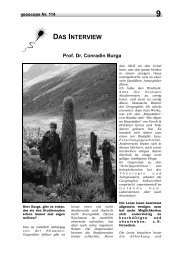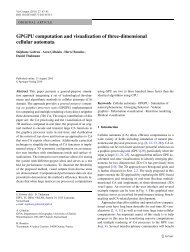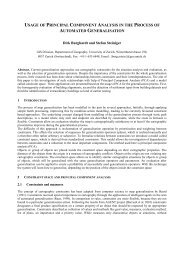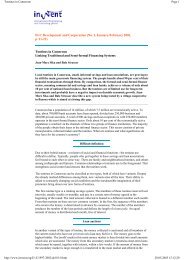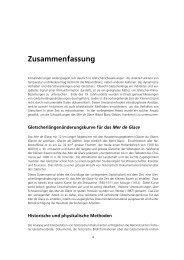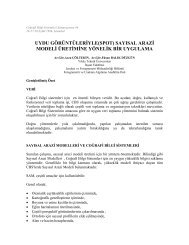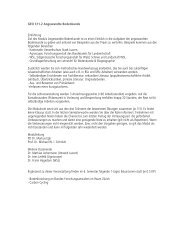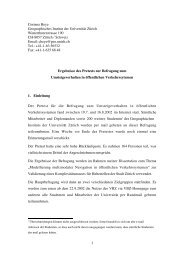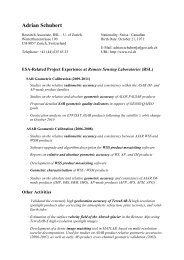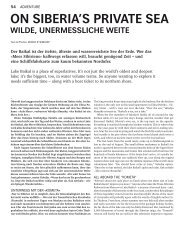KYRGYZSTAN TODAY Policy briefs on - Department of Geography
KYRGYZSTAN TODAY Policy briefs on - Department of Geography
KYRGYZSTAN TODAY Policy briefs on - Department of Geography
Create successful ePaper yourself
Turn your PDF publications into a flip-book with our unique Google optimized e-Paper software.
Timur Kozukulov,<br />
Senior lecturer, religious studies and humanities<br />
<strong>Department</strong> <strong>of</strong> Theology, Osh State University<br />
Searching for Soluti<strong>on</strong>s to the Problems <strong>of</strong> Islamic<br />
Educati<strong>on</strong> in Kyrgyzstan<br />
The spread <strong>of</strong> Islam in Kyrgyzstan has a l<strong>on</strong>g history. This process was complex<br />
and protracted for several centuries.<br />
Historically, Sunni Islam has dominated in the Republic. Sunni Islam <strong>of</strong> the<br />
Hanafite School is the most moderate <strong>of</strong> local groups <strong>of</strong> Islam. It is characterized by<br />
tolerance toward dissenters, compliance with local customs and traditi<strong>on</strong>s in daily life,<br />
and freedom <strong>of</strong> individual judgments in legal issues.<br />
The <strong>on</strong>set <strong>of</strong> Perestroika in the USSR in the 1980s initiated the revitalizati<strong>on</strong> and<br />
“revival” <strong>of</strong> religious life, especially in the Muslim republics. Since then, regi<strong>on</strong>al<br />
perspectives <strong>on</strong> religi<strong>on</strong> have changed dramatically. In Kyrgyzstan, as in all the republics<br />
<strong>of</strong> Central Asia, processes began <strong>of</strong> sovereignizati<strong>on</strong> and separati<strong>on</strong> <strong>of</strong> the republican<br />
kazyyats from the CASDM (Central Asian Spiritual Directorate <strong>of</strong> Muslims).<br />
After Kyrgyzstan gained independence, fundamental changes in its spiritual life<br />
have taken place. The religious spaces <strong>of</strong> Kyrgyzstan were revived. This resulted in the<br />
formati<strong>on</strong> <strong>of</strong> new state-religious relati<strong>on</strong>ships, an increasing number <strong>of</strong> religious sites,<br />
a dramatic increase in the number <strong>of</strong> pilgrims, greater publicati<strong>on</strong> and distributi<strong>on</strong> <strong>of</strong><br />
Islamic literature, emergence <strong>of</strong> a spiritual educati<strong>on</strong>al system, and the involvement <strong>of</strong><br />
religious organizati<strong>on</strong>s in social processes to better meet the spiritual needs <strong>of</strong> believers.<br />
N<strong>on</strong>-believers, Muslims, Christians and representatives <strong>of</strong> other religi<strong>on</strong>s form<br />
a multinati<strong>on</strong>al society in Kyrgyzstan, which c<strong>on</strong>sists <strong>of</strong> 30 major ethnic groups and<br />
representatives <strong>of</strong> more than 80 nati<strong>on</strong>alities.<br />
The populati<strong>on</strong> <strong>of</strong> Kyrgyzstan is much more diverse than those <strong>of</strong> Uzbekistan and<br />
Tajikistan. Only 79.9 percent <strong>of</strong> Kyrgyzstan’s populati<strong>on</strong> c<strong>on</strong>sider themselves Muslims.<br />
These include all the representatives <strong>of</strong> Uzbek and Tajik ethnic minorities, and 94.1<br />
percent <strong>of</strong> the ethnic Kyrgyz, although religious beliefs am<strong>on</strong>g the ex-nomadic Kyrgyz<br />
have not historically been str<strong>on</strong>g. Am<strong>on</strong>g those who c<strong>on</strong>sider themselves Muslim,<br />
70.9 percent are Moslems because <strong>of</strong> family traditi<strong>on</strong>s, while 14.8 percent believe that<br />
being Kyrgyz means being Muslim. Nevertheless, 40.3 percent rarely or never perform<br />
“namaz”, and 17.6 percent perform namaz <strong>on</strong>ly during religious holidays. Only 20.7<br />
percent perform namaz at least, <strong>on</strong>ce a day.<br />
Few people in Kyrgyzstan have formal religious educati<strong>on</strong> (6.4 percent). Most<br />
Moslems (24.9 percent) received basic religious educati<strong>on</strong> from their parents or relatives,<br />
while others did so individually (11.9 percent) [2, p. 5].<br />
129






